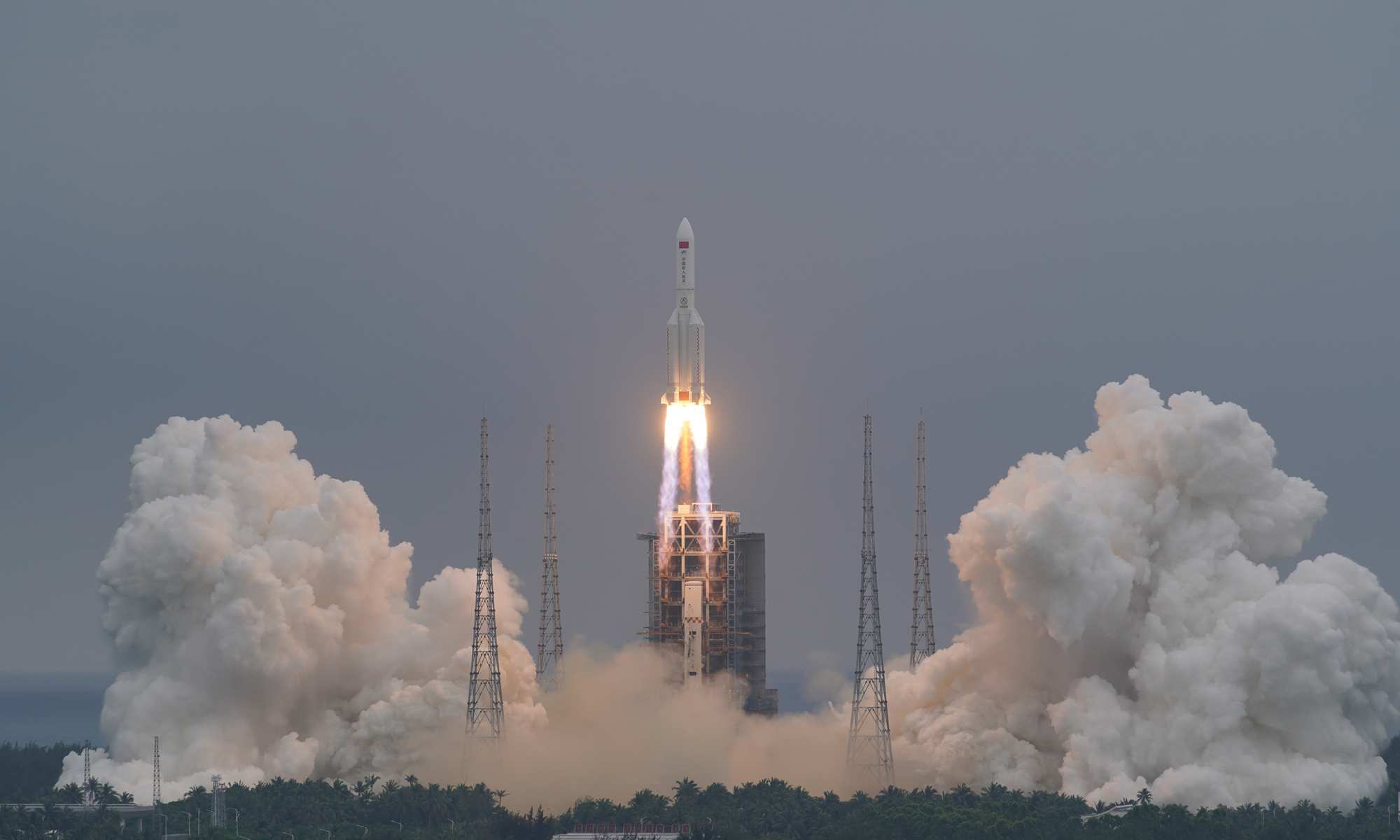China successfully launches core module for its space station, kicking off intense construction phase
China has successfully sent the first section of its own space station - the Tianhe core module cabin - into preset orbit via a Long March-5B Y2 carrier rocket from Wenchang spaceport in South China's Hainan Province on Thursday, kicking off an intense construction phase of the project.
Encased in the extra-large fairing of the country's state-of-the-art Long March-5B launch vehicle, the 16.6-meter-long, 4.2-meter-diameter Tianhe (literally meaning Harmony in Heaven) core module, rose from the tropical island province of Hainan at 11:23 am on Thursday morning. After a flight time of around one hour, the solar panels onboard the spacecraft smoothly unfolded and functioned normally, marking the mission's complete success, according to the China Manned Space Agency (CMSA.)
Chinese President Xi Jinping on Thursday offered his congratulationsregarding the successful launch of the core module of China's space station, noting that the mission's success marks the entry of China's space station construction into the full implementation stage, which lays a solid foundation for follow-up tasks.
Xi said in his congratulatory message, "I hope you will vigorously carry forward both the spirit of 'Two Bombs and One Satellite' and the spirit of manned spaceflight, be self-dependent and innovative to achieve victory in space station construction, and contribute to building a modern socialist country!"
The 22-ton Tianhe module will serve as the management and control center for China's future space station while hosting three astronauts for long-term in-orbit missions, the Global Times learned from the space station program contractor, the state-owned aerospace giant China Aerospace Science and Technology Corporation (CASC).
The Tianhe module, the largest, heaviest and most complicated spacecraft that China has developed to date, will provide astronauts a living and working space of approximately 50 cubic meters. This space will increase to some 110 cubic meters once the other two experiment modules are in place, CASC said.
As China officially starts implementing construction of its own space station on Thursday, space analysts said they believe that the country has earned its last piece of the big ticket to join the space power club, as it has conquered the every threshold to be counted among the calibre.
There is no doubt that China has become one of the very few countries in the world that have successfully retrieved lunar samples, and managed to send a robotic probe into Mars' orbit, the rover, of which is also expected to land on the Red Planet soon, and at the same time mastered almost every key technology for manned space flight, said Wang Ya'nan, chief editor of Aerospace Knowledge magazine.
Wang stressed that China has proceeded in a more pragmatic and measured fashion than both the US and the Soviet Union in their space race during the Cold War.
Dubbed the go-to rocket type for the space station module launch missions, the 53.66-meter-long Long March-5B, a shorter variant of Long March-5, has the largest 5.2-meter-diameter fairing of 20.5 meters in height, equivalent to a six-floor building, according to the rocket developer the China's Academy of Launch Vehicle Technology (CALT) under the CASC.
Compared to the Long March-5 type, which is more suitable for deep space exploration tasks including the lunar and Mars missions, Long March-5B excels in its launch capability to the low Earth orbit, developers at the CALT told the Global Times.
As the first runner of this relay-like mission, Long March-5B successfully delivered the core module launch section to the set orbit that is some 120- to 600-kilometers in low Earth orbit, they said.

Photo: Su Dong
30-year pursuit
Tianhe will be the first section of China's three-module space station, which is expected to be operational by around 2022, exactly three decades after the nation approved the Project 921 to develop human spaceflight in 1992.
An intense schedule of 11 launches has been set for the construction of China's space station which started Thursday and go through 2022. Three will be for modules, four for cargo spaceships and four for manned spaceships.
Following the core module's launch, the cargo spaceship Tianzhou-2 is expected to be sent into space in May if the system evaluation goes smoothly. The Shenzhou-12 crewed spacecraft is scheduled for launch in June, sending three astronauts into orbit for about three months, during which the regenerative life support system and maintenance will be tested.
The Tianzhou-3 cargo spaceship and Shenzhou-13 manned spaceship will be launched in September and October respectively, and three astronauts onboard the Shenzhou-13 spaceship will spend six months in orbit, which will be the "new normal" for future crew deployment, according to CMSA.
CMSA has referred to the maiden flight of the Long March-5B rocket in May 2020 and the five launches this year as the "key technology verification phase," while six other missions, including those for two lab capsules, set for next year, will be the "in-orbit construction phase."
Once built, China's space station, slated to operate at a 400-kilometer low Earth orbit, will also mark the final phase of China's three-step manned space development.
The development of manned spaceships was the first part of the program, during which China also achieved human space entry and exit. China sent its first astronaut, Yang Liwei, into orbit in October 2003, marking the highlight of the first stage.
China has overcome technological breakthroughs including spacewalks outside the cabin, docking in space and astronauts' medium-term stays, in the second phase, marked by the Tiangong-1 and -2 space labs. The country also carried out successful verification for in-orbit supply transfers during this stage.
Tiangong-2 crew member Chen Dong spent 33 days in space, setting a new benchmark in China manned space missions.

Photo: CAST
Smaller but more advanced than ISS
China's space station will be an extendable T-shaped form, with the core module at the center, cargo and crewed spaceships at each end, and two lab capsules named Wentian and Mengtian on each side.
The leading developer of China's space station is tasked with "supporting astronauts for long-term stays and large-scale space experiments, to engage in international cooperation that contributes to the peaceful development of space, and to gain experiences for future deep-space crewed missions," China Academy of Space Technology (CAST) explained.
Compared to the International Space Station (ISS), which weighs some 420 tons and is the largest orbital platform to date developed and built by 16 countries including the US, Russia, Canada and Japan over 12 years, "China's space station may not be as big but is more cost-efficient and technologically advanced in some areas, which can fully meet the demands of various kinds of space applications, " Bo Linhou, vice chief designer of Tianhe core module, said in a group interview prior to the launch.
By completion, the three modules of the space station will weigh more than 60 tons, and the whole space station will reach some 100 tons in weight when the modules are connected with the docking manned and cargo spaceships, according to Hao Chun, director of CMSA.
One of the key technologies that will be used onboard China's space station and will be tested on the core module is the urine processing and regenerative system, said Li Jiandong, senior engineer in charge of the system.
Bo also cited a number of new technologies applied on the core module, including information technology that allows broader bandwidth between space and Earth, as well as smart home applications that can be controlled via phone apps, providing a cozier living environment for astronauts onboard. Wireless communication is also installed using adapted wi-fi and Bluetooth technologies.
The room for in-cabin activities has expanded greatly compared to the Tiangong-1 and -2, which is over 100 cubic meters compared to the previous 15 cubic meters.
The faster network speed also allows more complex experiments to be conducted in China's space labs, Bo added, something the previous Tiangong-1 and -2 could not realize due to limited bandwidth. Now, with the capability of downloading larger quantities of data from space to the ground, more types of experiments can be carried out on China's space station.
China's space station is set to operate for 10 years and can be extended to 15 years with proper repair and maintenance, CAST explained.

Steps to build China's space station Infographic: Jin Jianyu/GT
As for the software onboard, Bo said it will not need an upgrade under normal circumstances as the R&D team already took into consideration the parts where maintenance will be needed in the future before its rollout. But if an upgrade is required, the network speed should be fast enough to support a new version to be uploaded from ground control center to space.
Another purpose for building the space station is to accumulate experiences for future deep space missions, including those to the Moon. The renewable life support system to be tested in space will further explore the possibility of growing grain and vegetables, eventually realizing a self-sufficient cycle on the Moon, Bo said.
Elaborating on space cooperation, Bo told the Global Times that it will mainly be carried out in payload experiments.
"Scientists from China and other foreign partners could jointly develop a payload device that will be brought to the station by cargo spacecraft, and after experiments are completed in orbit, the data could be shared with the international community."
He added that for foreign astronauts intending to board the space station, they can either take China's Shenzhou manned spaceships or launch their own and dock it with the station, but a docking mechanism in line with Chinese standards is required, which is different from the mechanism currently used by the ISS.
The Global Times has also learned from CAST that the Tianhe core module, the control center of the station, is able to accommodate the parking of up to three spacecraft.

Photo:Shi Xiao
International platform
China has been engaged in exchange and cooperation with international space agencies including Russia's Roscosmos and the European Space Agency (ESA), which played a positive role in the construction of China's space station. "We are willing to work with any space institutes that are peace loving and devoted to the peaceful use of space," Hao Chun, director of the China Manned Space Agency, told the Global Times, when asked whether China has plans to work with international space agencies and scientists including NASA.
However, the US legal instrument known as the "Wolf Amendment," which restricts any exchange of information between NASA and the China National Space Agency or other Chinese space organizations, has brought an end to the China-US space cooperation, Hao noted.
Hao also disclosed that "there will be foreign astronauts participating in China's manned space flight, and working and staying in China's space station."
"Many of them have been learning Chinese for this purpose. And China will carry out work to select foreign astronauts for joint flight missions as our construction of the space station proceeds," he said.
"Many of them have been learning Chinese for such purpose. And China will carry concerning work to select foreign astronauts for joint flight missions, as our construction of space station proceeds," he said.
A Reuters report quickly following the successful launch of the Tianhe core module on Thursday, said that in contrast, the fate of the ageing ISS - in orbit for more than two decades - remains uncertain, as the project is set to expire in 2024, barring funding from its partners. Russia said recently that it would quit the project from 2025.
It is good news for humanity that China's space station will very likely fill the void, and even better news for developing countries that have yet to cultivate their own space capabilities, Wang'Yanan, told the Global Times.
Compared to the US-dominated ISS, which is more of a party of powers since beginning, China's space station would be more inclusive in getting developing countries involved, and provide a platform for anyone on the basis of equality, win-win cooperation and mutual respect, Wang explained.

China's space station program Infographic: Xu Zihe/GT
Photos
Related Stories
- Xi says China ready to promote partnership with Uzbekistan
- Xi says China ready to continue strengthening vaccine cooperation with Hungary
- Commentary: China's space station to house more int'l cooperation
- Commentary: Rural vitalization indispensable to China's modernization
- Xi extends condolences to Chad's CMT head over death of President Deby
Copyright © 2021 People's Daily Online. All Rights Reserved.










